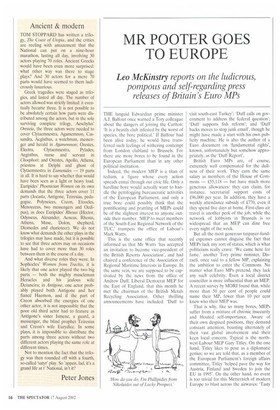Ancient & modern
TOM STOPPARD has written a trilogy, The Coast of Utopia, and the critics are reeling with amazement that the National can put on a nine-hour marathon, lasting all day, involving 30 actors playing 70 roles. Ancient Greeks would have been even more surprised: what other way was there to stage plays? And 30 actors for a mere 70 parts would have seemed to them ludicrously luxurious.
Greek tragedies were staged as trilogies, and lasted all day. The number of actors allowed was strictly limited: it eventually became three. It is not possible to be absolutely certain how parts were distributed among the actors, but in the sole surviving complete trilogy, Aeschylus' Oresteia, the three actors were needed to cover Clytaernnestra. Agamemnon, Cassandra, Aegisthus, a watchman, messenger and herald in Agamemnon; Orestes,
Electra, Clytaernnestra, Pylades, Aegisthus, nurse and servant in Choephori; and Orestes, Apollo, Athena, priestess at Delphi and ghost of Clytaemnestra in Eumenides — 19 parts in all. It is hard to say whether that would have been seen as a light or heavy load. Euripides' Phoenician Women on its own demands that the three actors cover 11 parts (Jocasta, Antigone, Teiresias, pedagogue, Polyneices, Creon, Eteocles, Menoeceus, two messengers and Oedipus), as does Euripides' Rhesus (Hector, Odysseus, Alexander, Aeneas, Rhesus, Athena, Muse, DoIon, shepherd, Diomedes and charioteer). We do not know what demands the other plays in the trilogies may have made, but it is possible to see that three actors may on occasions have had to cover more than 30 roles between them in the course of a day.
And what diverse roles they were. In Sophocles' Women from Trachis, it is likely that one actor played the two big parts — both the mighty muscleman Heracles and his jealous wife Deianeira; in Antigone, one actor probably played both Antigone and her fiancé Haemon, and if the part of Creon absorbed the energies of one other actor, it is not impossible that the poor old third actor had to feature as Antigone's sister Ismene, a guard, a messenger, the blind prophet Teiresias and Creon's wife Eurydice. In some plays, it is impossible to distribute the parts among three actors without two different actors playing the same role at different times.
Not to mention the fact that the trilogy was then rounded off with a fourth, so-called 'satyr' play. So 'appen, lad, it's a grand life at t' National, in't it?
Peter Jones






























































 Previous page
Previous page